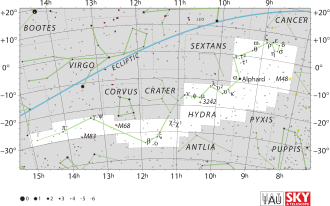One of the 88 IAU constellations.
Etymology and History
The Greek constellation of the Water Snake is a derivative of the Babylonian constellation of the MUŠ-Dragon, a dog-headed creature with the body of a gigantic snake with front legs and wings.
Origin of Constellation
Transfer and Transformation of the Constellation
the Babylonian version of the "Hydra and Corvus" super-constellation does not contain a cup or jar. visualized in Stellarium (drawing by Jessica Gullberg)
the lonely star in front of the dragon-head (Procyon) rised simultaneously with the faint stars of The Crab in ancient Babylon. Procyon and the head / foot of the dragon may serve as a replacement for Cancer
The Greeks introduced a Crater atop the snake. On the Farnese Globe, the body of the snake forms a vessel for Corvus and Crater.
In early modern time, some scholars extended the snake-body of Hydra beyond pi Hydrae and placed a second bird (Solitaire or Noctua) at this new end.
Mythology
Greek/ Greco-Roman folklore
Babylonian belief
Weblinks
References








